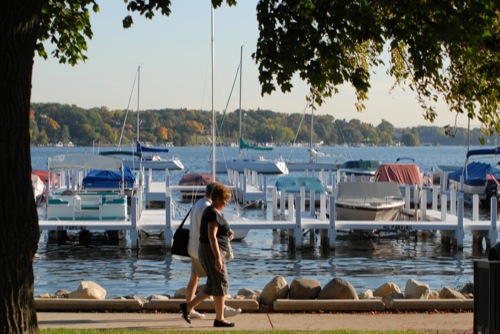
Courtesy LGACVB
“It’s a hot day in Chicago, I understand, but on this peaceful lake in southeast Wisconsin, a gentle breeze cools the summer air. At home, my factories continue to turn out products around the clock. But I’m not working this season — instead, I’m enjoying a lakeside holiday and the company of other wealthy socialites. Amidst the heat of the Industrial Age, this is the cool life for me.”
All right, this is not the 19th century, and I’m certainly no wealthy baron of Chicago industry. But on a long weekend’s trip to Lake Geneva, Wisconsin, it’s easy to imagine myself a midcentury magnate.
This small town and the Wisconsin countryside that surrounds it first gained prominence as a summer retreat for the Windy City wealthy in the 1800s. Today, the area maintains its peaceful aesthetic and affluent appeal, and attracts visitors, vacationers and tourists throughout the year. I spent three days touring the region last fall as a guest of the Wisconsin Department of Tourism, and the trip left me reflective and relaxed.
Cruising Geneva Lake
After spending a day on Geneva Lake, it’s not difficult to understand what made this area such a popular getaway for elite Chicagoans of the 19th century. With crystal clear water and beautiful foliage on 20 miles of shoreline, the lake is one of the natural treasures of the Midwest.
Throughout the late 19th and early 20th centuries, wealthy residents of Chicago bought land along the lake and built “summer cottages” of varying sizes. The most modest are the size of typical American homes; the most opulent are extraordinary mansions that showcase brilliant architecture and uncommon riches. Unlike most homes, they don’t face the road, which can be a quarter-mile or more away. Instead, they face the water.
“Between 1870 and 1920, they referred to this area as the Newport of the West,” said Captain Neil, who ferried me and a group of visitors around on a Lake Geneva Cruise Lines mail boat. “Eighty to 90 percent of what you see here are summer homes. The men who built these homes were the most influential men in Chicago.”
Today, many of those homeowners still take advantage of the mail boat service that began in 1916. Each morning in the summer, a private boat contracted by the U.S. Postal Service carries mail to the houses along the lakefront. The large boats pull up to each pier along the way, slowing down just enough for young “mail jumpers” to leap onto the dock, deliver the mail, retrieve outgoing pieces and jump back onto the boat, clinging to its exterior railing. Since the boat never stops moving for fear of colliding with the pier, the mail run is an impressive display of bravery and athleticism on the part of its delivery crew.
The mail boat has become such a beloved tradition in the area that it is among the most popular Lake Geneva activities for visitors. Groups can board the mail boat for morning runs, where they’ll get an up-close view of the impressive dock jumping, as well as great narration about the history of some of the magnificent homes they pass along the way.
Fun at the Fireside
From Lake Geneva, it’s only 40 miles to Fort Atkinson, so I took the next day to pay a visit to the famous Fireside Dinner Theatre. The theater has a long track record as one of the most popular group attractions in Wisconsin, and a matinee visit would demonstrate why.
Jackie Brisko was waiting for me when I arrived at the Fireside. I’ve known Brisko for years, and see her often at tourism conferences and trade shows around the country. But on her home turf, her pride was infectious as she walked me and several other visitors through the halls of the Fireside.
“The Fireside opened 47 years ago as a pyramid restaurant in the middle of a cornfield,” she told us. “Today, we’re the only professional Equity theater in the state of Wisconsin. We do most of our auditioning in New York.”
The Fireside has won accolades as a retail destination, a restaurant and a live theater. My visit started with lunch, which demonstrated the organization’s commitment to culinary quality. Meals at the Fireside are themed according to the show in the theater and served in a separate dining room. Depending on the time of day, groups can have a plated dinner served tableside or enjoy a buffet with a wide range of options.
After a meal, there is time for a visit to the Fireside’s on-site bakery, as well as a quick spin through the retail area. A serious shopper could spend hours there.
“We have four really fabulous gift shops,” Brisko said. “They have 50,000 items, all that can fit under a motorcoach.”
When showtime came, I joined the audience for a presentation of “Seven Brides for Seven Brothers.” The Fireside emphasizes clean, classic shows in its programming season, and this production fit the bill to a T. Because the company hires professional actors, the performance featured great singing, acting and dancing. And the stage is configured in the round, so I had an up-close view, just like every other patron in the theater.









